Campaigns Overview
- Get Started
- Release Notes
- Triggers
- Patient Channel
- Troubleshooting and FAQ
- Patient Facesheet
- Technical Specifications
- Insights & Analytics
- Inbox
- Conversation Flows
- Campaigns
- Lines & Resources Requests
- Lines, Events, Resources
- SMS Basics
- Automations
- Referrals
- AI Agents
- Add-Ons
- Users and Groups
- Platform Settings and Configuration
- Self-Rescheduling
- Recalls
- Marketplace
- Artera Harmony Federal Edition
Table of Contents
Who can create and send Campaigns?Who can receive Campaigns?Building CampaignsCampaign MessageCampaign Schedule Final ReviewEnabling CampaignsWhen Bulk Messages do not suit your delivery volume needs, consider using Campaigns. With Campaigns, you can create and send large volume outreach—up to 30,000 patients per Campaign—and stop building call and mailing lists.
Campaigns are often used to notify targeted patients of a new service offering or to fill a gap in care. Campaigns can also be pre-scheduled to send on a specific date, allowing you to more efficiently meet messaging needs.
If interested in setting up automatic Campaigns, without user intervention, click here to learn about Recurring Campaigns.
Who can create and send Campaigns?
Campaigns can be sent out by the user type indicated on the Permissions page.

Who can receive Campaigns?
Campaigns can be sent to any patient that exists within the Artera Enterprise, it is not limited to the patients present in the Artera Practice. Additionally, campaigns can be sent to Unverified Patients (but not those who are manually added). Click here to learn more.
Building Campaigns
Create a Campaign
Let's review how to create a Campaign.
-
From the Navigation Bar, select Campaigns > Campaigns.
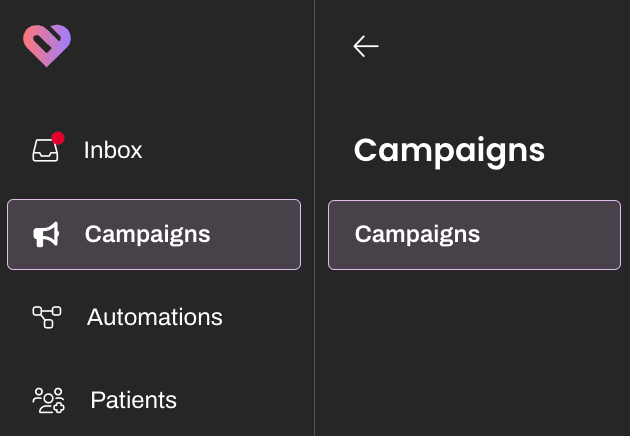
-
Select Create Campaign on the top-right corner of the page.
NOTE: Ensure you've selected the correct Practice, displayed in the Practice dropdown menu.
-
Enter a Campaign Name (e.g. Vaccination Reminder, Flu Vaccine, etc). This name is not patient-facing and serves as the Campaign's title.

-
Select the Practice to send the Campaign from.

-
Select the Line to associate with this Campaign. Patient responses to the Campaign will be directed to the selected line.
NOTE: Only line(s) that are enabled in the selected Practice will display.
-
Select a Category that best matches the Campaign's objective. Reporting on Campaigns by category is available to Analytics Plus customers.
 Consider the following when choosing a category.
Consider the following when choosing a category.
NOTE: Categories cannot be changed or retroactively added once a Campaign is created:- Appointment (reminders, instructions, etc): Select this category if the campaign message is pertaining to an upcoming or past appointment, such as preparation instructions, follow-up information, etc.
- Clinical (test results, prescriptions, etc): Select this category if the campaign message includes clinical information or links out to clinical information.
- Financial (billing, insurance etc): Select this category if the campaign message includes financial or billing information, including but not limited to insurance details, balances, etc.
- Health System Update (provider departure, hours changes, etc): Select this category if the campaign message includes operational information that may impact a patient, such as office closures, provider changes, construction, etc.
- Marketing (events, programs, etc): Select this category if the campaign message is related to non-specific or non-urgent events or programs, such as fitness classes, educational events, etc.
- Other: Select this category if the campaign's objective does not fit into any other existing category.
- Portal Invitation: Select this category if the campaign message includes links to patient portal sign–up or login.
- Scheduling: Select this category if the campaign message encourages patients to schedule a new appointment.
- Referral: Select this category if the campaign message includes links or instructions for scheduling referrals.
- Survey: Select this category if the campaign message includes links to a survey or satisfaction form for the patient to complete.
-
Select continue. Now, you will identify the patients to send the Campaign to. There are two options on how to upload your Campaign's Audience Source and with each, up to 30,000 patients can be reached.

CSV of MRNs:
Upload a .CSV file containing the unique Patient IDs (typically an MRN) from your EMR. Although CSV (comma delimited), CSV (Macintosh), and CSV (MS-DOS) are supported, we recommend saving your file as an MS-DOS Comma Separated (.csv) file, if available. This prevents empty rows and decreases the time it takes to upload and digest the file.
Drag and drop the file into the white box or select Choose File to open the file selector.
Important: If your Patient IDs contain leading zeros, be sure the file saved contains the leading zeros. To do this, select your data range in the file and press Ctrl+1 on your keyboard to launch the Format Cells dialog. On the Number tab, select Text. NOTE: This will not change the format of the Patient IDs already entered into the file. It will only affect Patient IDs entered after the new data format is applied. If these steps do not work for your file, please connect with your IT Team.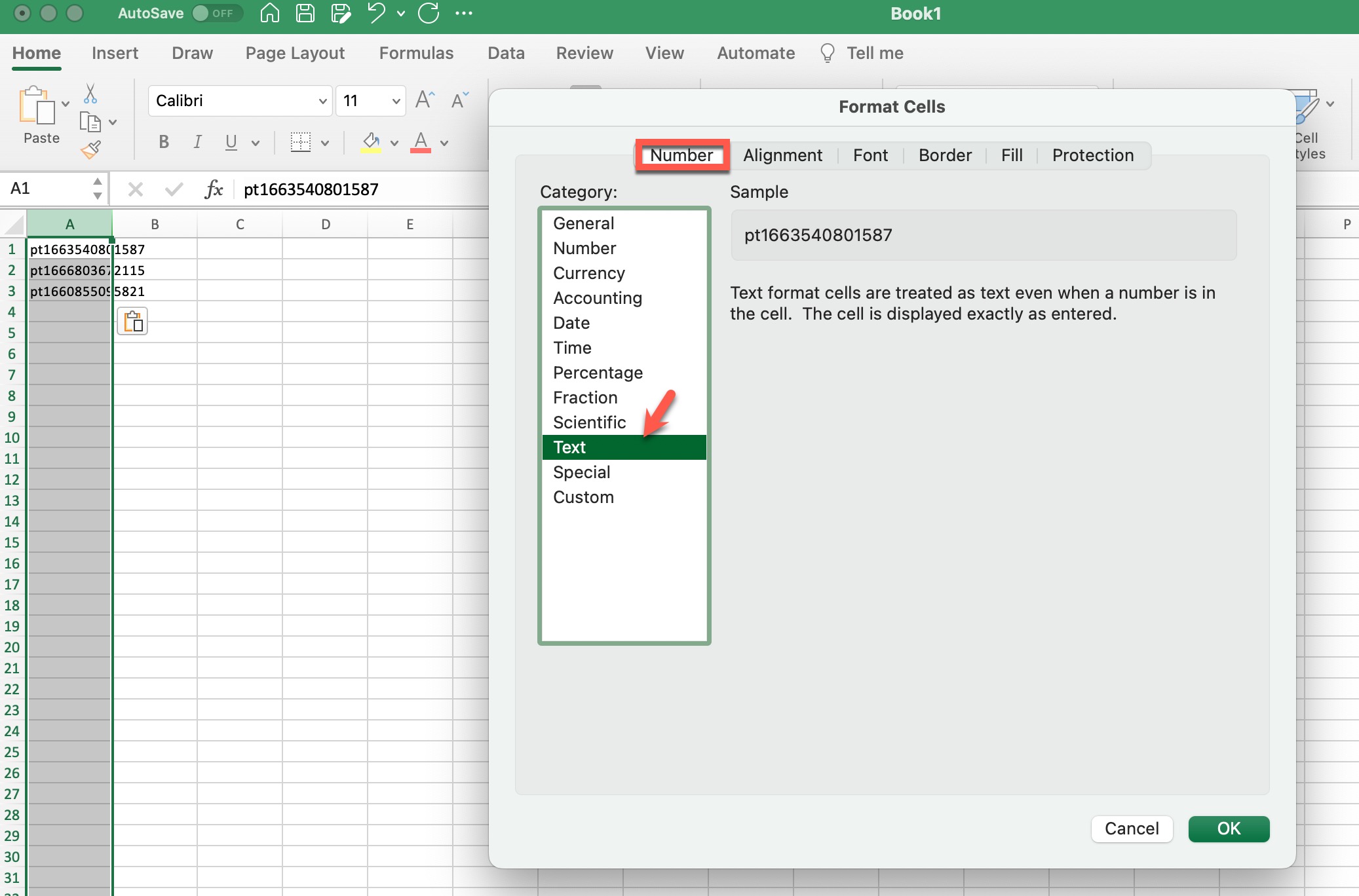 This file must be under 500KB (which is around 30,000 patients) and include a single column of MRNs/patient IDs in Column A with no header and no additional information. Typically, you can export a report from your EMR containing the IDs and remove the extra information.
This file must be under 500KB (which is around 30,000 patients) and include a single column of MRNs/patient IDs in Column A with no header and no additional information. Typically, you can export a report from your EMR containing the IDs and remove the extra information. .jpeg) Once the file is uploaded, the file name will display in the "Audience" section. To remove the file, select Remove. Once ready, select Continue.
Once the file is uploaded, the file name will display in the "Audience" section. To remove the file, select Remove. Once ready, select Continue.
NOTE: Duplicate MRNs included in the .CSV file are automatically removed in order to prevent patients from receiving identical messages from the Campaign.Patients with Appointments:
Choose this Audience Source method to select a date or date range to view the patients who have appointments during that time frame within the Practice that is associated with the Campaign. Then, narrow the loaded patient list for the Campaign by leveraging the Audience Filters available. This Audience Source option is ideal for sending time-sensitive updates to a large group of patients with scheduled appointments. You can use it to notify patients of an upcoming office closure, inform them about a provider who is out sick, give a heads-up about parking lot construction, and more.
Use the Audience Filters to filter your appointment search by appointment status ("confirmed", for example), locations (departments), Events (appointment types), or providers. Once filters are applied, select the “Refresh” button on the right-hand side of the page to obtain a count of matching patients.
Once filters are applied, select the “Refresh” button on the right-hand side of the page to obtain a count of matching patients.
NOTE: You are not able to identify which patients fit your filtering criteria. That information can be accessed in the last step of Campaign configuration. See the "Final Review" section below for more information.
Campaign Message
Create your message for each of the desired delivery options (text, call, email). When crafting your Campaign, note that a text message segment can contain up to 160 characters. If a Campaign's message consists of more than 160 characters, it will be sent as multiple messages, referred to as concatenated messages. Each message in a concatenated series has a maximum character limit of 153. Messages sent in languages other than English have varying character limits. Learn more about SMS character limits here.
To increase deliverability, we recommend building messages for both text and call. You can choose to craft your own message or use a Quick Response.

NOTE: If you have selected "Patients with Appointments" as your audience in the previous step, do note that a patient with multiple appointments within the chosen timeframe will receive the Campaign message for each of their appointments. To help patients distinguish between messages for their appointments, include Event Smart Phrases in your message.
Manual Message
-
Use the appropriate Smart Phrases to personalize the message. Use the Smart Phrase wand to identify the supported Smart Phrases based on Audience Source.
-
NOTE: Smart Phrase use is limited within Campaigns, as Event, Referral, and Discharge Smart Phrases cannot be used if the Audience Source for the Campaign is an upload of patient MRNs. If your Audience Source for the Campaign is "Patients with Appointments," all Smart Phrases are supported. We recommended using Event Smart Phrases to help patients distinguish between messages for their appointments.
NOTE: Line breaks are supported in Campaigns.
-
NOTE: Smart Phrase use is limited within Campaigns, as Event, Referral, and Discharge Smart Phrases cannot be used if the Audience Source for the Campaign is an upload of patient MRNs. If your Audience Source for the Campaign is "Patients with Appointments," all Smart Phrases are supported. We recommended using Event Smart Phrases to help patients distinguish between messages for their appointments.
- To prevent your Campaign from being deciphered as spam by patient phone carriers, you must include opt out language within your message. A common example of opt out language is: "Reply STOP to unsubscribe."
-
Unsecured Campaign text messages must be under 1,600 characters, otherwise, the Campaign will fail to send and you will receive a warning. If the Campaign includes Smart Phrases, the character limit is reduced to 1,000. You can check this by ensuring the denominator of the fraction of the character count in the bottom right corner of the message is equal to 10 or less. Learn more about SMS Character Limits and Message Formatting Guidelines. If including a link in your message, URLs over 25 characters are automatically shortened by Artera. Click here to learn about Artera's Link Shortening.
-
NOTE: Community Outreach messages should be sent as unsecured (ensure the lock icon is open) messages.
-
NOTE: Community Outreach messages should be sent as unsecured (ensure the lock icon is open) messages.
- Choose whether to send your text and email messages as Secure or Unsecure.
- Campaigns respect patient language preferences, so you can add translations if supported by your integration.
-
Optional:
-
Include an attachment up to 1MB. To do this, drag and drop the file into the "Attach File" box or select "Choose File" to upload it manually. Supported file types include: MP4, MOV, PNG, JPG, JPEG, BMP, GIF, and PDF.
NOTE: Campaigns attachments are only available to Artera Harmony customers. Please connect with your Customer Success Representative, if interested.
-
Include an attachment up to 1MB. To do this, drag and drop the file into the "Attach File" box or select "Choose File" to upload it manually. Supported file types include: MP4, MOV, PNG, JPG, JPEG, BMP, GIF, and PDF.
Quick Response
NOTE: When using Quick Responses with Campaigns, remove any Event (i.e {eventDate}), Referral, or Discharge Smart Phrases within the Campaign. These Smart Phrases will not work unless you have selected "Patients with Appointments" as your Audience Source for the Campaign. Use the Smart Phrase wand to identify which Smart Phrases are supported by Campaigns.
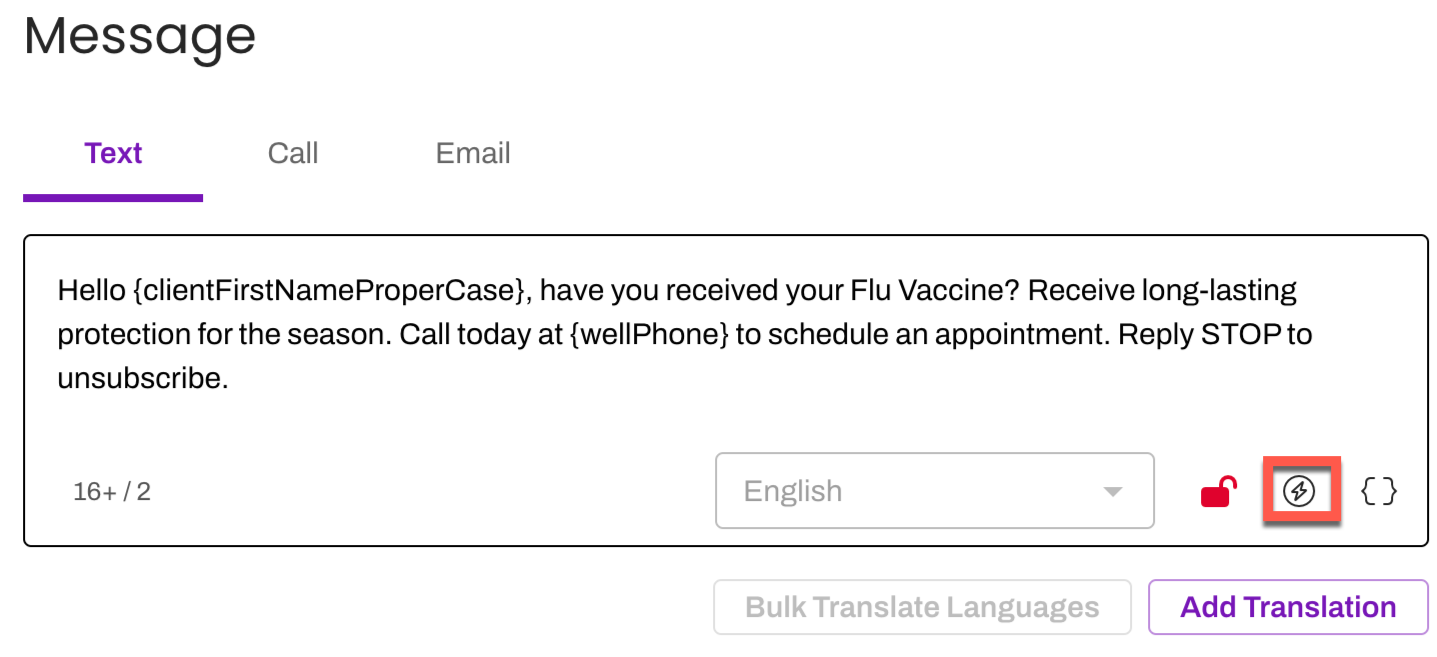
Preview Phone Call
You can validate how your call message will sound by previewing the phone call. In the sample call, any Smart Phrases will be randomly populated with generic placeholders.
- Click the Phone icon at the bottom of the message.

- Enter a valid 10-digit U.S. phone number and select Call Me.
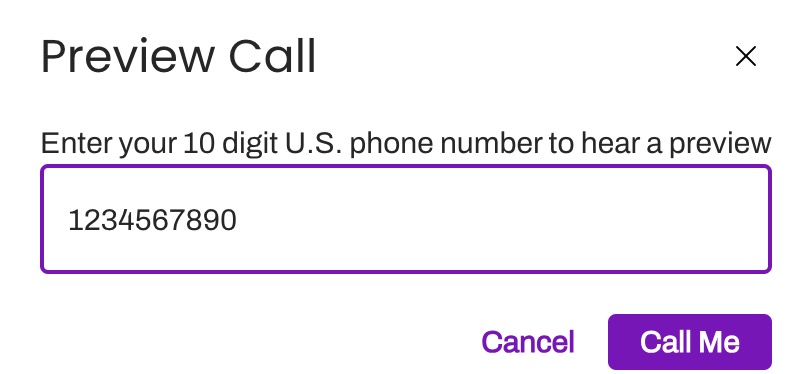
- Once the phone rings, be sure to say Hello to activate the message delivery.
Campaign Schedule
Next, determine when the Campaign should be sent. A Campaign's Start Date and Start Time are automatically set to the current date and time. However, if you want to schedule the Campaign for a later delivery, these can be modified.
If configuring a Campaign to start running on a future date, the Campaign's start time will default to 9:00 AM and can be modified, if necessary. If the user changes the start date back to today's date, the start time will remain at 9:00 AM and can be modified as well. NOTE: Campaigns follow your Practice's timezone.
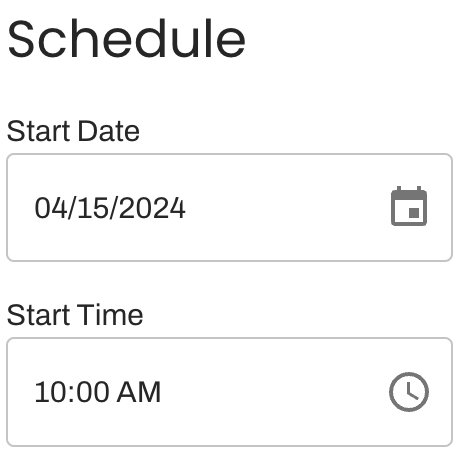
Send Only Between the Hours of
Depending on the volume and cadence of messages you are looking to send, the Campaign may send over several days. Use these delivery time slots to indicate which hours of the day are okay to send the Campaign.

For Campaigns where you want patients to engage with you (e.g. text or call to schedule a visit), ensure the volume of responses is manageable for your team. For example, if you have a staggered start and your full staff is only on shift from 10:00 AM-3:00 PM, consider settings delivery times based on staff availability.
NOTE: Campaigns respect TCPA Hours and therefore, can only be set to send between 8:00 AM - 9:00 PM in your Practice's timezone. If the Campaign's daily start and end times fall outside TCPA mandated hours, the following error message will appear:

Send on Business Days Only?
Use the checkbox to choose whether this Campaign should only be sent on business days. Business days for Campaigns are determined by your Practice hours. Any day that your Practice is open for any duration of time counts as a "business day" for Campaigns.

If you are running a Campaign that asks the patient to engage with you, we recommend enabling this setting. This ensures that someone will be available to respond to the patient quickly.
NOTE: In Practices set up for one-way messaging, all days are business days, so this toggle will not impact Campaigns.
Send From
Determine which line will be used to send the Campaign. By default, High Volume Toll-Free Number is selected. Artera can use a high volume toll-free number to send the Campaign in order to circumvent the restrictions that phone carriers place on the number of texts that can be sent from a single phone number.
Sending the Campaign from a toll-free number helps increase its deliverability and prevents patients' phone carriers from perceiving your phone number as spam. This is especially beneficial if the Campaign is being sent to a large audience. However, at times, this can create a disjointed patient experience for those who receive other messages from Artera through your Practice line(s), such as appointment reminders and manual messages.
To allow for a more seamless patient experience, you can also send the Campaign from the Practice line selected in step one of the Campaign's creation. NOTE: Campaign calls are always made from your Practice line, regardless of whether your Enterprise's toll-free number is selected when configuring the Campaign.
If a patient opts out of messaging through a Campaign, the downstream impact of the opt-out will depend on which number was used to deliver the Campaign and from which Practice the Campaign was sent from. Click here to learn about Campaigns opt-out implications.

Review the table below to help you determine how to send the Campaign to your audience.
High Volume Toll-Free Number |
Practice Line |
Better for large audiences (thousands of patients) |
Better for small audiences (hundreds of patients) |
Better for time-sensitive messages |
Patients will receive the Campaign directly from the Practice line |
NOTE: Campaign calls made to patients use your Practice's line, not your Enterprise's high volume toll-free number.
Messages to Send per Hour
Set how many Campaign messages you would like to send per hour (text, call, email). Do note that text message segments impact a Campaign's send rate as messages longer than 160 characters (in English) are split into multiple segments, each counting towards your message send rate. Therefore, it is important to be mindful of a Campaign's text message length to optimize delivery. However, each call made from a Campaign counts as one message, regardless of how many characters are included in the call message.
If the Campaign is being sent from the Practice line, this rate can be set to a maximum of 1,248 call or text messages per hour, with up to 104 call or text messages sent every 5 minutes. This is because Practice lines are also used to send other messages to patients, such as Bulk Messages, Triggers, and manual messages.
If the high volume toll-free number is selected to send the text message Campaign from, this rate can be set using increments of 12 messages per hour, with a maximum rate of 2,496 messages per hour. However, Artera sends an evenly distributed amount of messages every 5 minutes.
For Campaigns where you anticipate a large number of responses, consider reducing the send rate. This ensures you will have enough staff to engage with patient responses without being overwhelmed.
Click and drag the slider to change the speed of call and/or message delivery; you will notice the text below the slider will update with the chosen rate.

Final Review
Finally, preview your Campaign and ensure that the details are accurate. The information in the "Audience" section varies based on which Audience Source was chosen for the Campaign.
CSV of MRNs
In the "Audience" section, select Download CSV of Audience to view the patients who will be reached with the Campaign. The "Audience Size" displays how many patients will be reached. The "Invalid MRNs" header displays how many MRNs within your uploaded CSV file were marked invalid by Artera. Click here for information on eligible patients for Campaign Delivery. The "Duplicate MRNs" header displays how many duplicate MRNs were removed from the uploaded CSV file in order to prevent patients from receiving repeated messages from the Campaign.
Patients with Appointments
In the "Audience" section, the appointment filters chosen are displayed. Select Download CSV of Audience to view the patient IDs (MRNs) of the patients who will be reached with the Campaign. The "Total Patients" header displays how many patients will be reached based on the Audience Filters applied.
You can also review the Campaign's send dates/times and message content. When ready, select Create Campaign.

Enabling Campaigns
Once you have saved your Campaign, it will automatically be placed in a "pending" status. To start the Campaign, select the Actions (...) menu and choose Start.
NOTE: Even if the Campaign was configured to start with the current date and time, it will begin in the "pending" status and must be manually started.
Important: Once you start a Campaign, you cannot edit any of the settings.

Once enabled, the Campaign will move into the "queued" status until the indicated start date and time is reached. If the Campaign runs over multiple days, it will automatically move from the "running" to the "paused" status based on its start and end time. To learn more about Campaign management, click here.